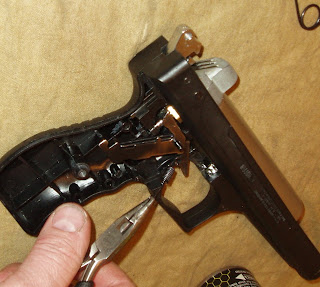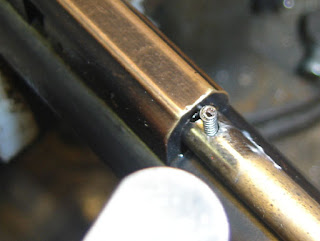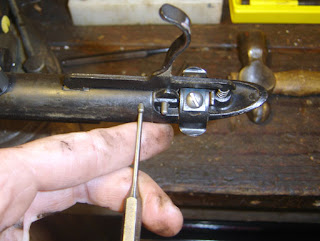Please keep in mind that the Beeman P17 has also been sold as the Beeman 2006 and the Marksman 2004. Currently, it goes by the Beeman P17 moniker. Beeman must still be moving through old packaging, as I just saw a gun marked "P17" in a Beeman 2006 clamshell package. They are all essentially the exact same gun and as far as I have been able to ascertain, all the parts are completely interchangeable.
So, if you aren't yet moved to fully disassemble your own P17, here are a few easy tasks that solve most of the gun's annoying little problems. Note: It is unnecessary to remove the entire barrel shroud assembly for the following modifications.

The rear sight screw has a wonderful tendency to back out and cause your point of impact to gradually climb higher and higher. Fun! The simple fix is a slightly longer M4 x .7mm bolt and a corresponding nylock nut.

Nut goes on the inside. I coated the threads of the bolt with a medium strength loctite and allowed it to dry before installation. Care should be exercised when using thread locking products around plastics--like most of this gun. Many plastics don't care for anaerobic thread locking compounds and will be permanently damaged if they come into contact. Be safe and let the compound dry completely on the bolt threads before assembly as a precaution.

Another common problem with the P17 is the tendency for the top cover's rearmost cross pin to wander out of location. That would be the long pin at the far right. A 4-40 tap and a couple 4-40 setscrews will hold it fast. The "latch that looks like a hammer" holds onto this pin when the top cover is closed.

Push the cross pin out with a drift and run the tap through the holes that appear to be made for this exact purpose. Seems like the manufacturer just knew that pin wouldn't stay in place by itself. And it doesn't!

I'm not even sure I needed a tap handle for this. (maybe not even the tap!) The plastic is that soft. While I had the pin out, I also took a couple seconds and polished it--paying attention only to the center latching area.

Started the tiny 4-40 setscrews with a .05" allen wrench, reinstalled the cross pin and GENTLY snugged the screws down.

It's imperative that the setscrews be flush or below flush with the bottom edge.

I did the same procedure with the bottom half of the frame, too. The "hammer that functions only as a latch" also sits on a cross pin. I did NOT remove this pin as I didn't want to fight the latch spring to reinstall. I did start with the tap and ran the setscrews home with the allen wrench. The plastic is actually so soft, I bet I could carefully run the setscrews in without even tapping the frame first. Again, the holes were already molded into the frame. Lucky! And again, the setscrews need to be flush or below.

This small strap, affixed with 2 phillips head screws, holds the barrel in place.

Removing the strap allows the barrel to be slid backward about 1/8" and then straight down and out.

I re-cut the crown on the Taig lathe. It's important to not shorten the muzzle more than a hundredth of an inch or so. This step can be omitted if you don't have access to a lathe.

Next, I polished the breech end of the barrel. This end gets slid across the breech o-ring at the end of the stroke every time the gun is cocked. A smooth surface here will minimize wear on that breech o-ring.

The goal here is simply a nice, smooth finish. Excess metal removal will make the breech effectively too short to reach the o-ring, causing some velocity loss.

This is all we're after.

While the barrel is still out, it's cleaning time. It's unlikely I'll ever remove the barrel again, so the gloves are off. I used J-B Non-Embedding bore cleaner and made a dozen passes. Cleaned it until the patches came clean then finished it off with a good polarizing oil to protect the rifling. Even if you don't want to give the barrel a top notch cleaning, remember to remove the buffing compound from the breech polishing by patching the barrel several times.
I'll get back to the complete overhaul next time.


















































